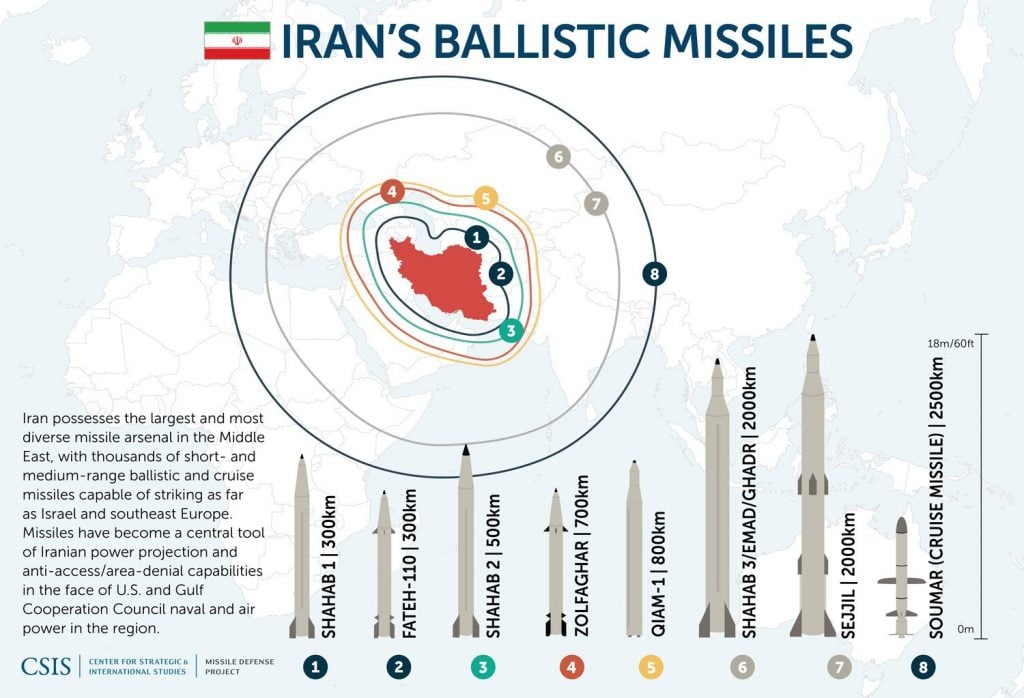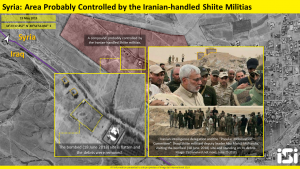
Types and ranges of Iranian missiles (Graphic by Center for Strategic & International Studies)
Amidst rising tensions in the Persian Gulf, an Iranian-made ballistic missile exploded on launch in Yemen yesterday, killing both Houthi militiamen and their Iranian advisors. Israeli sources said today that the accident occurred at the al-Dulaimi army base, 10 miles outside the Yemeni capital of Sana’a, near the international airport.
But other Iranian-backed attacks seem to have proceeded smoothly. None of the US, British, French, and local naval forces in the Gulf prevented the Iranian boats or submarines approaching their targets, although the US has released aerial video it said showed an Iranian patrol boat removing a mine that had failed to explode, presumably to hide the evidence of Iranian involvement. Israeli sources expressed alarm that neither Israel, the US, nor allied Arab nations picked up any advance warning of what appear to have been well-planned, well-executed, and increasingly destructive attacks by Iranian and proxy forces.
- On May 12, off the coast of the United Arab Emirates, divers attached magnetic “limpet” mines to four tankers — two Saudi, one Emirati, and one Norwegian — and set them off within minutes of each other, doing minor damage. While the Emiratis didn’t name a perpetrator, it’s likely that Iranian marines or special operators placed the mines.
- On May 14, seven Houthi drones crossed 500 miles of Saudi territory undetected — an unprecedented attack for the Iranian-backed rebel group — and damaged a major oil pipeline, forcing it to shut down temporarily.
- On May 19, a rocket launched into the high-security Green Zone in Baghdad launched within a mile of the US embassy, although it remains unclear if the target was the embassy or any number of Iraqi government facilities in the same area. Iraq’s politically powerful and well-armed Shiite militias, long backed by Iran, denounced the attack and denied any involvement, but some sources see it as a warning shot, implicitly threatening a larger and more accurate barrage if the crisis escalates.
- On June 1st, a rocket launched from Syria — probably by the Iran-backed Hezbollah militia — struck an Israeli ski resort on Mount Hermon, doing minor damage. Israel responded with airstrikes that reportedly killed 10 Hezbollah and Syrian military personnel.
- On June 12th, a missile struck Abha Regional Airport in southern Saudi Arabia, injuring 26 people, eight of them seriously enough to require hospital treatment. The strike is believed to have been the first employing, not the ballistic missiles long used by the Houthi rebels, but the Iranian-built Soumar cruise missile. The Soumar appears derived from the Russian Kh-55, of which Iran illegally purchased a dozen from Ukraine in 2001.
- On June 13th, explosions struck two tankers — one Norwegian, one Japanese — forcing both crews to evacuate. Reports are so far unclear whether they were hit by limpet mines, missiles, or a mix of both, with one Japanese source saying the ship was struck by a “flying object.” The video of Iranians removing an unexploded mine involved one of these ships. The US also reported the Iranians fired an anti-aircraft missile at an American drone monitoring their actions.
The Iranians, particularly the well-armed Revolutionary Guard Corps, have a flotilla of small Fast Attack Craft — basically militarized speedboats equipped with missiles and RPGs — backed by a few more exotic technologies such as the Zolfaqar semi-submersible torpedo boat.
Meanwhile, on land, the Iranians continued building up the allied Assad regime in Syria and their Lebanese Hezbollah proxies. Syria is reportedly building a new airport to service light aircraft and helicopters, which would allow both troops and weapons to move rapidly between Syria and Lebanon. Israel has been attacking Iranian shipments of rockets and other munitions to Hezbollah as they transit Syrian territory, but once the shipments reach Lebanese soil, they are relatively safe.
Sources also report that Hezbollah uses underground tunnels near the new airfield to cross unseen between Syria and Lebanon.

Courtesy ImageSat International
Perhaps of greatest concern to the US: Iran announced today it is increasing the enrichment of uranium and its stockpile will exceed the limit set by the Joint Comprehensive Plan Of Action (JCPOA) — from which Trump withdrew — by June 27th.
It’s worth noting that none of the attacks so far has shut off the flow of oil through the Strait of Hormuz or directly targeted US forces, either of which would bring immediate retaliation. “They are very cautious,” Eldad Shavit, senior researcher at the Israeli Institute of National Security Studies, told Breaking Defense. The Iranians historically avoid high-risk brinksmanship, he said, but now they clearly feel that “in the face of efforts to make them sign a new nuclear deal, there is no option of doing nothing.”
Another Israeli source told Breaking Defense that the Iranians may well trigger a war without wanting to: “They act very cautiously, but the atmosphere is full of fuel fumes, and any small incident can result in a huge explosion.”
Navy jet trainer fleet operations remain paused after engine mishap
One week after the incident, a Navy spokesperson says the service is continuing to assess the fleet’s ability to safely resume flight.


























